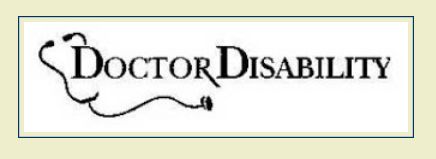Petitioner DrDisabilityQuotes.com seeks cancellation of two registrations, one for the word-and-design mark shown below ("the Stethoscope Mark") and the other for the standard character mark DOCTOR DISABILITY, both for insurance brokerage services. Respondent Krugh moved under FRCP12(b)(6) to dismiss the two counts aimed at the standard character mark - fraud and likelihood of confusion - assertin that petitioner had failed to state claims on which relief can be granted. The Board denied the motion. DrDisabilityQuotes.com, LLC v. Charles Krugh, Cancellation No. 92074232 (March 5, 2021) [precedential].

In the DOCTOR DISABILITY standard character application, Krugh claimed acquired distinctiveness under Section 2(f) by way of its ownership of the Stethoscope Mark registration and also by way of use of the standard character mark for at least five years.
Fraud: A properly pleaded fraud claim must allege that:
Rule 9(b) of the Federal Rules of Civil Procedure requires that fraud be pleaded "with particularity." Petitioner alleged that Krugh's Section 2(f) claim was false and misleading because Krugh had abandoned and ceased using the Stethoscope Mark, and also because he had not used the DOCTOR DISABILITY standard character mark for the five years preceding his Section 2(f) claim. Petitioner further alleged that these false statements were material to his application, were made with the intent to deceive the USPTO, and were relied upon by the USPTO in issuing the registration.
The Board found that petitioner's allegations satisfied the requirements of FRCP 9(b), and it concluded that petitioner had stated a claim for fraud on the USPTO.
Likelihood of Confusion: In order to state a Section 2(d) claim, a plaintiff must allege that it owns prior proprietary rights in a mark or name for its good or services, and use by the defendant of a mark or name that is likely to cause confusion, mistake, or deception of consumers as to the source of the goods or services. See Herbko Int'l., Inc., v. Kappa Books, Inc., 308 F.3d 1156, 64 U.S.P.Q.2d 1375, 1378 (Fed. Cir. 2002); Hornblower & Weeks, Inc. v. Hornblower & Weeks, Inc., 60 U.S.P.Q.2d 1733, 1735 (T.T.A.B. 2001).
Petitioner alleged that it owns prior common law rights in the mark DrDisabilityQuotes.com for the same services as those of Krugh, that the standard character mark DOCTOR DISABILITY is confusingly similar to Petitioner's mark, and that there results a likelihood of confusion in the marketplace.
Krugh contended that the claim should be dismissed because Petitioner could not establish priority. He alleged that he enjoys "constructive priority under 15 U.S.C. Section 1057(c) because of the registration of the Stethoscope Mark in 2006," the priority of which may be tacked onto the standard character mark.
The Board, however, found Krugh's tacking argument to be premature. A motion to dismiss under FRCP 12(b)(6) tests only the sufficiency of the pleaded allegations, not the merits of the claim. Once Krugh files his answer, he may plead tacking and then he may try to establish "the stringent elements of tacking."
And so the Board concluded that petitioner had properly pleaded a Section 2(d) likelihood of confusion claim.
Read comments and post your comment here.
TTABlogger comment: Petitioner also alleged that Krugh committed fraud when he stated false first use dates. The Board pointed out in a footnote that, as long as the mark was in use in commerce as of the filing date of the application, false first use dates are not material to the issuance of the registration and thus cannot support a fraud claim. See Hiraga v. Arena, 90 U.S.P.2.d 1102, 1108 (T.T.A.B. 2009).
BTW: Do you think that Krugh's two marks are similar enough for tacking? In any case, Petitioner also claims that the Stethoscope Mark has been abandoned.
The content of this article is intended to provide a general guide to the subject matter. Specialist advice should be sought about your specific circumstances.

